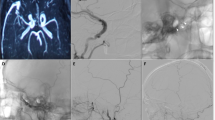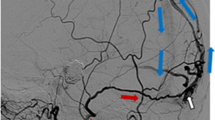Abstract
Purpose
Cranial nerve dysfunction (CND) is not uncommon in patients with cavernous dural arteriovenous fistulas (cDAVFs), and may represent an initial manifestation or a complication after endovascular treatment. This study evaluated the outcome of CND associated with cDAVFs after transvenous embolization (TVE) using Onyx.
Materials and Methods
Forty-one patients with cDAVFs were treated with TVE in our department between April 2009 and October 2013. For each patient, clinical and radiologic records were retrospectively reviewed and evaluated, with an emphasis placed on evaluating the outcomes of the pre-existing cDAVF-induced CND and the TVE-induced CND.
Results
Of the 41 cases, 25 had a history of preoperative CND. Postoperatively, gradual remission to complete recovery (CR) within 8 months was observed in 17 of these cases, transient aggravation in 7, and significant improvement to be better than preoperative function but no CR in 1. All aggravation of CND occurred immediately or within 1 day after TVE and resolved completely within 5 months. Nine patients developed new CND after TVE. New CND occurred during the perioperative period in 8 cases, but all cases resolved completely within 15 days–6 months. Delayed CND was observed in 3 cases with a time lag of 3–25 months after TVE. Two of these completely resolved within 20 days–1 month and the remaining case significantly improved.
Conclusion
Both the pre-existing cDAVF-induced CND and the TVE-induced new or aggravated CND completely resolved in almost all cases after embolization with Onyx.


Similar content being viewed by others
References
Kim MS, Han DH, Kwon OK, Oh CW, Han MH (2002) Clinical characteristics of dural arteriovenous fistula. J Clin Neurosci 9(2):147–155
Chung SJ, Kim JS, Kim JC, Lee SK, Kwon SU, Lee MC, Suh DC (2002) Intracranial dural arteriovenous fistulas: analysis of 60 patients. Cerebrovasc Dis 13(2):79–88
Kai Y, Hamada J, Morioka M, Yano S, Kuratsu J (2007) Treatment of cavernous sinus dural arteriovenous fistulae by external manual carotid compression. Neurosurgery 60(2):253–257; discussion 257–258
Stiebel-Kalish H, Setton A, Nimii Y, Kalish Y, Hartman J, Huna Bar-On R, Berenstein A, Kupersmith MJ (2002) Cavernous sinus dural arteriovenous malformations: patterns of venous drainage are related to clinical signs and symptoms. Ophthalmology 109(9):1685–1691
Sasaki H, Nukui H, Kaneko M, Mitsuka S, Hosaka T, Kakizawa T, Kimura R, Nagaseki Y, Naganuma H (1988) Long-term observations in cases with spontaneous carotid-cavernous fistulas. Acta Neurochir (Wien) 90(3–4):117–120
Meyers PM, Halbach VV, Dowd CF, Lempert TE, Malek AM, Phatouros CC, Lefler JE, Higashida RT (2002) Dural carotid cavernous fistula: definitive endovascular management and long-term follow-up. Am J Ophthalmol 134(1):85–92
Halbach VV, Higashida RT, Hieshima GB, Reicher M, Norman D, Newton TH (1987) Dural fistulas involving the cavernous sinus: results of treatment in 30 patients. Radiology 163(2):437–442
Satomi J, Satoh K, Matsubara S, Nakajima N, Nagahiro S (2005) Angiographic changes in venous drainage of cavernous sinus dural arteriovenous fistulae after palliative transarterial embolization or observational management: a proposed stage classification. Neurosurgery 56(3):494–502; discussion 494–502
Takahashi S, Sakuma I, Tomura N, Watarai J, Mizoi K 2004) Transvenous embolization of dural arteriovenous fistula of the cavernous sinus. Fistulous points and route of catheterization. Interv Neuroradiol 10(Suppl 1):85–92 (Epub 9 June 2008)
Kato S, Ishihara H, Nakayama H, Fujii M, Fujisawa H, Kajiwara K, Nomura S, Sadanaga H, Suzuki M (2007) Transvenous embolization for dural arteriovenous shunt of the cavernous sinus. Comparison of multi-staged transvenous embolization and transvenous embolization with sinus packing. Interv Neuroradiol 13(4):353–358. Epub 1 Feb 2008
Kim MJ, Shin YS, Ihn YK, Kim BM, Yoon PH, Oh SY, Kim BS (2013) Transvenous embolization of cavernous and paracavernous dural arteriovenous fistula through the facial vein: report of 12 cases. Neurointervention 8(1):15–22 (Epub 28 Feb 2013)
Jiang C, Lv X, Li Y, Wu Z, Shi J (2013) Surgical access on the superior ophthalmic vein to the cavernous sinus dural fistula for embolization. J Neurointerv Surg 5(3):e13. doi:10.1136/neurintsurg-2011-010227. Epub 2 March 2012
Kashiwazaki D, Kuwayama N, Akioka N, Kuroda S (2014) Delayed abducens nerve palsy after transvenous coil embolization for cavernous sinus dural arteriovenous fistulae. Acta Neurochir (Wien) 156(1):97–101
Nishino K, Ito Y, Hasegawa H, Kikuchi B, Shimbo J, Kitazawa K, Fujii Y (2008) Cranial nerve palsy following transvenous embolization for a cavernous sinus dural arteriovenous fistula: association with the volume and location of detachable coils. J Neurosurg 109(2):208–214
Kim DJ, Kim DI, Suh SH, Kim J, Lee SK, Kim EY, Chung TS (2006) Results of transvenous embolization of cavernous dural arteriovenous fistula: a single-center experience with emphasis on complications and management. Am J Neuroradiol 27(10):2078–2082
Lv X, Jiang C, Li Y, Yang X, Wu Z (2010) Recovery of ophthalmoplegia associated with cavernous sinus dural arteriovenous fistulas after transvenous cavernous sinus packing. Eur J Radiol 75(2):139–142 (Epub 12 May 2009)
Aihara N, Mase M, Yamada K, Banno T, Watanabe K, Kamiya K, Takagi T (1999) Deterioration of ocular motor dysfunction after transvenous embolization of dural arteriovenous fistula involving the cavernous sinus. Acta Neurochir (Wien) 141(7):707–709; discussion 709–710
Lv X, Jiang C, Li Y, Wu Z (2009) Percutaneous transvenous packing of cavernous sinus with Onyx for cavernous dural arteriovenous fistula. Eur J Radiol 71(2):356–362 (Epub 2 June 2008)
Liu A, Liu J, Qian Z, Peng T, Li Y, Yang J, Wu Z, Jiang C (2014) Onyx embolization of cavernous sinus dural arteriovenous fistulas via direct transorbital puncture under the guidance of three-dimensional reconstructed skull image (reports of six cases). Acta Neurochir (Wien) 156(5):897–900 (Epub 6 March 2014)
Agid R, Willinsky RA, Haw C, Souza MP, Vanek IJ, terBrugge KG (2004) Targeted compartmental embolization of cavernous sinus dural arteriovenous fistulae using transfemoral medial and lateral facial vein approaches. Neuroradiology 46(2):156–160 (Epub 4 Dec 2003)
Sergott RC, Grossman RI, Savino PJ, Bosley TM, Schatz NJ (1987) The syndrome of paradoxical worsening of dural-cavernous sinus arteriovenous malformations. Ophthalmology 94(3):205–212
Acknowledgments
This work was funded by the National Science Foundation of China (Grant Nos. 81171079, 81220108007, 81371314, and 81471167), and the Special Research Project for Capital Health Development (Grant No. 2014-1-1071).
Conflict of interest
Chuanhui Li, Yang Wang, Youxiang Li, Chuhan Jiang, Zhongxue Wu, and Xinjian Yang declare that they have no conflict of interest.
Author information
Authors and Affiliations
Corresponding author
Rights and permissions
About this article
Cite this article
Li, C., Wang, Y., Li, Y. et al. Cranial Nerve Dysfunction Associated with Cavernous Dural Arteriovenous Fistulas After Transvenous Embolization with Onyx. Cardiovasc Intervent Radiol 38, 1162–1170 (2015). https://doi.org/10.1007/s00270-015-1062-y
Received:
Accepted:
Published:
Issue Date:
DOI: https://doi.org/10.1007/s00270-015-1062-y




